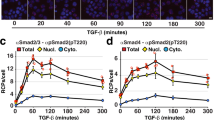Abstract
Proximity ligation assay (PLA) is a well-established method for detecting in situ interactions between two epitopes with high resolution and specificity. Notably, PLA is not only a robust method for studying protein–protein interaction but also an efficient approach to characterize and validate protein posttranslational modifications (PTM) using one antibody against the core protein and one against the PTM residue. Therefore, it could be applied as a powerful approach to detect specific interactions of endogenous phosphoinositides and their binding proteins within cells. Importantly, we have specifically detected the PLA signal between PtdIns(4,5)P2 and its binding effector p53 in the nucleus. This cutting-edge method fully complements other conventional approaches for studying phosphoinositide–protein interactions and provides important localization signals and robust quantitation of the detected interactions. Here, we present the PLA fluorescence protocol for detecting in situ phosphoinositide–protein interactions in cultured cells and is semiquantitative for interactions that are regulated by cellular signaling.
Access this chapter
Tax calculation will be finalised at checkout
Purchases are for personal use only
Similar content being viewed by others
References
Weibrecht I, Leuchowius KJ, Clausson CM et al (2010) Proximity ligation assays: a recent addition to the proteomics toolbox. Expert Rev Proteomics 7(3):401–409. https://doi.org/10.1586/epr.10.10
Bagchi S, Fredriksson R, Wallen-Mackenzie A (2015) In situ proximity ligation assay (PLA). Methods Mol Biol 1318:149–159. https://doi.org/10.1007/978-1-4939-2742-5_15
Fredriksson S, Gullberg M, Jarvius J et al (2002) Protein detection using proximity-dependent DNA ligation assays. Nat Biotechnol 20(5):473–477. https://doi.org/10.1038/nbt0502-473
Iwabuchi E, Miki Y, Ono K et al (2017) In situ detection of estrogen receptor dimers in breast carcinoma cells in archival materials using proximity ligation assay (PLA). J Steroid Biochem 165:159–169. https://doi.org/10.1016/j.jsbmb.2016.05.022
Thymiakou E, Episkopou V (2011) Detection of signaling effector-complexes downstream of BMP4 using in situ PLA, a proximity ligation assay. J Vis Exp 49:UNSP e2631. https://doi.org/10.3791/2631
Karamouzis M, Dalagiorgou G, Georgopoulou U et al (2015) Proximity ligation assay (PLA) to identify HER2-negative breast carcinomas responding in HER-3 targeting agents. J Clin Oncol 33(15)
Bedzhov I, Stemmler MP (2015) Applying the proximity ligation assay (PLA) to mouse preimplantation embryos for identifying protein-protein interactions in situ. Methods Mol Biol 1233:57–64. https://doi.org/10.1007/978-1-4939-1789-1_6
Maszczak-Seneczko D, Sosicka P, Olczak T et al (2016) In situ proximity ligation assay (PLA) analysis of protein complexes formed between Golgi-resident, glycosylation-related transporters and transferases in adherent mammalian cell cultures. Methods Mol Biol 1496:133–143. https://doi.org/10.1007/978-1-4939-6463-5_11
Chen M, Zhang Y, Yu VC et al (2014) Isthmin targets cell-surface GRP78 and triggers apoptosis via induction of mitochondrial dysfunction. Cell Death Differ 21(5):797–810. https://doi.org/10.1038/cdd.2014.3
Chen M, Qiu T, Wu J et al (2018) Extracellular anti-angiogenic proteins augment an endosomal protein trafficking pathway to reach mitochondria and execute apoptosis in HUVECs. Cell Death Differ 25(11):1905–1920. https://doi.org/10.1038/s41418-018-0092-9
Chen M, Choi S, Jung O et al (2019) The specificity of EGF-stimulated IQGAP1 scaffold towards the PI3K-Akt pathway is defined by the IQ3 motif. Sci Rep 9(1):9126. https://doi.org/10.1038/s41598-019-45671-5
Sehat B, Tofigh A, Lin Y et al (2010) SUMOylation mediates the nuclear translocation and signaling of the IGF-1 receptor. Sci Signal 3(108):ra10. https://doi.org/10.1126/scisignal.2000628
Choi S, Chen M, Cryns VL et al (2019) A nuclear phosphoinositide kinase complex regulates p53. Nat Cell Biol 21(4):462–475. https://doi.org/10.1038/s41556-019-0297-2
Kalasova I, Faberova V, Kalendova A et al (2016) Tools for visualization of phosphoinositides in the cell nucleus. Histochem Cell Biol 145(4):485–496. https://doi.org/10.1007/s00418-016-1409-8
Chen M, Wen T, Horn HT et al (2020) The nuclear phosphoinositide response to stress. Cell Cycle 19(3):268–289. https://doi.org/10.1080/15384101.2019.1711316
Author information
Authors and Affiliations
Corresponding author
Editor information
Editors and Affiliations
Rights and permissions
Copyright information
© 2021 Springer Science+Business Media, LLC, part of Springer Nature
About this protocol
Cite this protocol
Chen, M., Horn, H.T., Wen, T., Cryns, V.L., Anderson, R.A. (2021). Assessing In Situ Phosphoinositide–Protein Interactions Through Fluorescence Proximity Ligation Assay in Cultured Cells. In: Botelho, R.J. (eds) Phosphoinositides. Methods in Molecular Biology, vol 2251. Humana, New York, NY. https://doi.org/10.1007/978-1-0716-1142-5_9
Download citation
DOI: https://doi.org/10.1007/978-1-0716-1142-5_9
Published:
Publisher Name: Humana, New York, NY
Print ISBN: 978-1-0716-1141-8
Online ISBN: 978-1-0716-1142-5
eBook Packages: Springer Protocols




